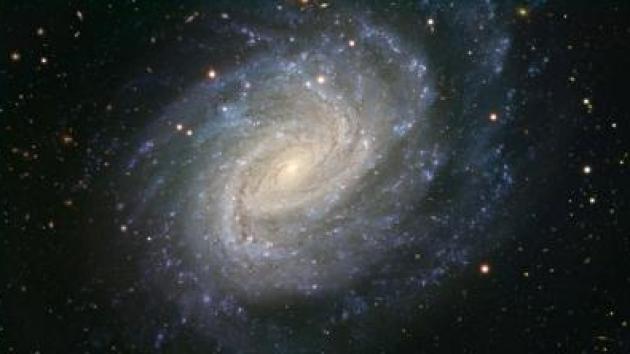
A seemingly tranquil galaxy that has been the scene of violent cosmic events has been captured in new telescopic images, European astronomers said.
The galaxy, NGC 1187, discovered by English astronomer William Herschel in 1784, looks tranquil and unchanging but it has hosted two supernovae explosions since 1982, they said.
The galaxy‘s half a dozen prominent spiral arms containing large amounts of gas and dust show bluish features indicating the presence of young stars born out of the clouds of interstellar gas, a release from the European Southern Observatory’s headquarters in Garching, Germany said.
In October 1982, the first supernova -- a violent stellar explosion, resulting from the death of either a massive star or a white dwarf in a binary system -- was observed in the galaxy by the ESO‘s LA Silla Observatory in Chile, then in 2007 a second supernova was observed by an amateur astronomer in South Africa.
The newly released image of NGC 1187, which is 60 million light-years from Earth, was created from observations taken as part of a yearlong study following the more recent supernova, which can still be seen shining long after the time of maximum brightness near the bottom of the image, astronomers said.(UPI)
<관련 한글 기사>
원, 투! 대폭발을 두 차례나 맞은 은하
고요해 보이는 이 은하는 사실은 우주 폭력이라고 할 만한 사건의 현장이다.
유럽 천문학자들이 은하 NGC 1187의 최신 사진을 공개했다.
은하 NGC 1187은 1784년 영국의 천문학자 윌리엄 허셜에 의해 처음 발견되었다. 이 조용해보이는 은하는 겉으로 아무 변화도 없는 것처럼 보이지만 1982년 이래로 무려 두 번의 초신성 폭발이 있었다.
유럽 남방 천문대에 따르면 이 나선 은하의 주요 나선팔 6개는 어마어마한 양의 가스와 성간물질을 포함하고 있다. 푸르스름한 색깔은 이 성간 가스에서 별들이 새롭게 태어난다는 것을 말해준다.
1982년 10월 첫 번째 초신성은 칠레에 있는 유럽 남방 천문대의 LA Silla 천문대에서 관측되었다. 2007년에 또 한 차례의 초신성 폭발이 있었으며, 이는 남아프리카의 아마추어 천문학자에 의해 관측되었다.
초신성 폭발은 태양 질량의 10 배 이상 되는 아주 무거운 별의 최종 진화 단계이다. 말하자면 별의 죽음으로, 거대한 별은 죽음의 순간에 엄청난 빛과 에너지를 방출한다. 이 때 초신성이 내뿜는 빛은 10억개의 별을 가진 은하의 밝기와 같다.
초신성 폭발을 두 차례나 맞은 은하 NGC 1187은 지구에서 6천 만 광년이나 떨어져 있다. 이번에 공개된 사진은 최신 초신성 폭발에 대한 연구의 일환으로 촬영되었다.
코리아헤럴드(khnews@heraldcorp.com)
The galaxy, NGC 1187, discovered by English astronomer William Herschel in 1784, looks tranquil and unchanging but it has hosted two supernovae explosions since 1982, they said.
The galaxy‘s half a dozen prominent spiral arms containing large amounts of gas and dust show bluish features indicating the presence of young stars born out of the clouds of interstellar gas, a release from the European Southern Observatory’s headquarters in Garching, Germany said.
In October 1982, the first supernova -- a violent stellar explosion, resulting from the death of either a massive star or a white dwarf in a binary system -- was observed in the galaxy by the ESO‘s LA Silla Observatory in Chile, then in 2007 a second supernova was observed by an amateur astronomer in South Africa.
The newly released image of NGC 1187, which is 60 million light-years from Earth, was created from observations taken as part of a yearlong study following the more recent supernova, which can still be seen shining long after the time of maximum brightness near the bottom of the image, astronomers said.(UPI)
<관련 한글 기사>
원, 투! 대폭발을 두 차례나 맞은 은하
고요해 보이는 이 은하는 사실은 우주 폭력이라고 할 만한 사건의 현장이다.
유럽 천문학자들이 은하 NGC 1187의 최신 사진을 공개했다.
은하 NGC 1187은 1784년 영국의 천문학자 윌리엄 허셜에 의해 처음 발견되었다. 이 조용해보이는 은하는 겉으로 아무 변화도 없는 것처럼 보이지만 1982년 이래로 무려 두 번의 초신성 폭발이 있었다.
유럽 남방 천문대에 따르면 이 나선 은하의 주요 나선팔 6개는 어마어마한 양의 가스와 성간물질을 포함하고 있다. 푸르스름한 색깔은 이 성간 가스에서 별들이 새롭게 태어난다는 것을 말해준다.
1982년 10월 첫 번째 초신성은 칠레에 있는 유럽 남방 천문대의 LA Silla 천문대에서 관측되었다. 2007년에 또 한 차례의 초신성 폭발이 있었으며, 이는 남아프리카의 아마추어 천문학자에 의해 관측되었다.
초신성 폭발은 태양 질량의 10 배 이상 되는 아주 무거운 별의 최종 진화 단계이다. 말하자면 별의 죽음으로, 거대한 별은 죽음의 순간에 엄청난 빛과 에너지를 방출한다. 이 때 초신성이 내뿜는 빛은 10억개의 별을 가진 은하의 밝기와 같다.
초신성 폭발을 두 차례나 맞은 은하 NGC 1187은 지구에서 6천 만 광년이나 떨어져 있다. 이번에 공개된 사진은 최신 초신성 폭발에 대한 연구의 일환으로 촬영되었다.
코리아헤럴드(khnews@heraldcorp.com)






![[Weekender] How DDP emerged as an icon of Seoul](http://res.heraldm.com/phpwas/restmb_idxmake.php?idx=644&simg=/content/image/2024/04/25/20240425050915_0.jpg&u=)




![[Music in drama] An ode to childhood trauma](http://res.heraldm.com/phpwas/restmb_idxmake.php?idx=644&simg=/content/image/2024/04/25/20240425050929_0.jpg&u=)






![[Herald Interview] Mistakes turn into blessings in street performance, director says](http://res.heraldm.com/phpwas/restmb_idxmake.php?idx=652&simg=/content/image/2024/04/28/20240428050150_0.jpg&u=20240428174656)
